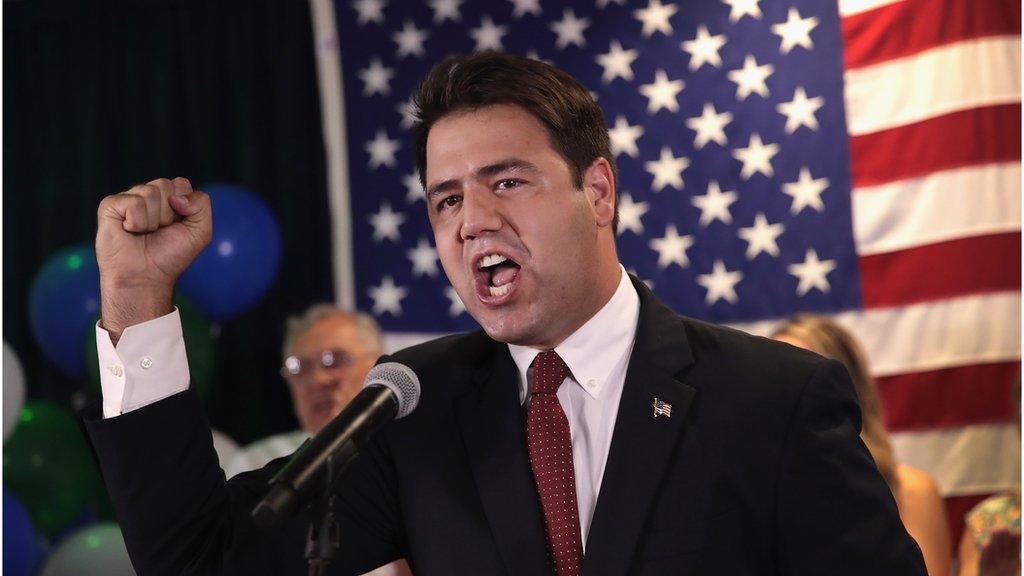US mid-term elections: What the results mean for Trump
- Published

Democrat Danny O'Connor has not conceded yet in the congressional race in Ohio
Four states held primary elections on Tuesday, but all eyes were on Ohio's special congressional election.
The state has lost a bit of its reputation as a bellwether state, but it was an early harbinger of Donald Trump's 2016 strength in the industrial Midwest. That helps explain why Tuesday's congressional race - the last major special election before November's national mid-terms - was so closely watched.
Although that contest has yet to be decided, there are some lessons to be learned from the race - as well as other results from a busy night in politics across the US.

Another warning bell for Republicans
In Ohio, Republicans were scrambling to boost Troy Balderson to victory and maintain control of a congressional seat they have held for 35 years. The party poured money into the race, Donald Trump held a rally to support the candidate and John Kasich - the still-popular Ohio Republican governor - cut a last-minute television advertisement.
It appears to have been enough - barely - although Mr Balderson only has a 1,754-vote lead with a reported 3,435 provisional and at least 5,048 absentee ballots left to be counted later this month.
Regardless of who wins - and this seat will be up for election again in November - the takeaways are clear. This was a congressional district that Mr Trump won by 11% over Hillary Clinton in 2016. The Republican incumbent, who retired at the beginning of this year, consistently cruised to victory with more than 60% of the vote
This was supposed to be a safe seat - but it wasn't.

The suburban swing
The election results revealed a clear urban-rural divide, as the Franklin County suburbs of the Ohio capital Columbus went overwhelmingly for Democrat Danny O'Connor. Outlying areas backed Mr Balderson, although turnout was well down from 2016.
That's a dynamic that could play out time and time again in November, which could be bad news for Republicans running in key suburban swing districts.
According to the Cook Political Report, external, there are 68 Republican-held congressional districts less conservative than this one. Democrats have to flip 23 to win control of the House.
Mr Trump, in a tweet (prematurely) congratulating Mr Balderson on his victory concluded by writing that "November can't come fast enough".
It's sentiment with which many Democrats will probably agree.

More good news for Democrats
Missouri voters rejected a proposal to pass a "right to work" law, which would have allowed employees in union-represented companies to decline to pay non-member dues to support collective bargaining efforts.
The state's Republicans had scheduled the vote during the state's primary, rather than the general election, in the hopes that Democratic turnout would be lower. They were wrong. The measure lost by 35%.
In Washington state, which has a primary system where candidates from all parties compete and the top two move on to the general election, Republicans are also contemplating less-than-encouraging showing.
While all the results aren't in, two Republican incumbents are pulling less than 50% of the vote, including Cathy McMorris Rodgers, a member of the party's congressional leadership. In an open Seattle-area seat that has been held by Republicans since 1983, the party's candidate, Dino Rossi, garnered only 43% against mostly Democratic opponents.
Back in the Republican wave year of 1994, Washington was ground zero for the decimation of the Democratic congressional ranks, losing - among others - the sitting Speaker of the House, Tom Foley.
This year it could help spell Republican doom.

A progressive stumble?
In June, first time candidate Alexandria Ocasio-Cortez, campaigning as a Democratic Socialist, shocked the political world by winning a New York primary challenge against a top-ranking Democratic member of Congress.
Critics cautioned not to read too much into the results, however, theorising that Ms Ocasio-Cortez's across-the-board progressive agenda played well in her New York borough district but wouldn't fly in other parts of the US.
That conclusion faced a big test on Tuesday, and the results were a mixed bag.
What young people think of Democratic Party's future
In the Michigan governor's primary, the highest-profile Democratic race, Gretchen Whitmer comfortably defeated Abdul El-Sayed, who was attempting to be the first Muslim-American governor in US history.
Ms Ocasio-Cortez and progressive icon Bernie Sanders had both campaigned for Mr El-Sayed in the run-up to the election, but their support ended up being not nearly enough.
The progressive duo also campaigned for labour lawyer Brent Welder, but after a long night of vote-counting he narrowly fell to Sharice Davids, who was backed by a powerful women's political group.
Elsewhere in Michigan, Rashida Tliab - who was backed in a crowded field by Justice Democrats, the same political action group that boosted Ms Ocasio-Cortez and other progressive candidates - won her primary and is virtually assured of being the first Muslim-American woman in Congress.
Even if some progressives stumbled on Tuesday, however, the party as a whole - including more traditional "establishment" candidates - continues to move toward widespread support for policies like universal healthcare and debt-free or no-tuition college education. Even in losing the battles, the Democratic left appears to be winning the war.

Trump's primary power
Donald Trump's overall popularity with the US public may be mired in the low 40s, but he's approaching record levels of support within Republican ranks.
That approval once again translated into an ability to move votes through his primary endorsements - as it had in recent contested races in South Carolina, Alabama and Georgia.
In Michigan on Tuesday, his chosen candidate to challenge Democratic Senator Debbie Stabenow cruised to an easy win. In Kansas Kris Kobach - an early Trump backer who chaired the president's now defunct election fraud commission - is locked in a tight, yet-to-be decided race against incumbent Republican governor Jeff Colyer.
Many Republican Party elders had urged Mr Trump to stay out of Kansas, believing Mr Colyer - who had been appointed to fill a governorship vacancy - would be the better general-election candidate. The president rewarded Mr Kobach, an outspoken advocate of conservative immigration reform and voting restrictions, for his loyalty with a coveted endorsement, however.
It may end up enough to tip the scales in his favour.

The year of the (Democratic) woman
The "Pink Wave": How women are shaping the 2018 US elections
Another round of primaries, another round of wins for women candidates - particularly among Democratic ranks.
Democrats have now nominated women for at least eight of the 36 governors elections this November (Republicans have selected three).
Tuesday's balloting also ensured a record number of major-party women candidates running for the US House of Representatives, at 185 - besting the previous mark of 167 with many primaries left to be held.
The #MeToo movement that broke on the national stage last year appears to be exerting a gravitational pull on US politics, although the true test will be not in nominations secured but political offices won in November.

Join the conversation

As Americans prepare to go to the polls in November, what are the issues that matter to you? And if you live outside the US, what do you want to know about politics here?
Send us your comments or questions to AskAmerica@bbc.co.uk and we will respond as part of our Ask America series, a project getting different perspectives from around the country.
